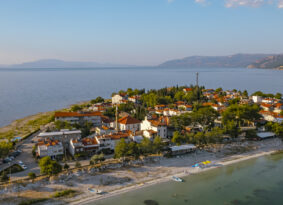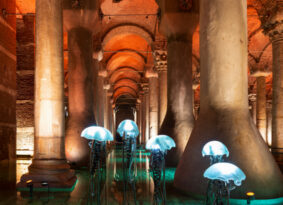İstanbul, the bustling metropolis of Türkiye, is a city full of charm, where the past goes hand in hand with the present and every step brings to light a relic of times gone by. At the crossroads of two continents – Europe and Asia – this spectacular city has absorbed the best of both worlds. Heir to civilizations, İstanbul is the perfect spot to discover the historical heritage of Türkiye. The city has a lot to offer from all-time favorites that illustrate Eastern Roman and Ottoman grandeurs to boutique museums that exhibit private collections. İstanbul awaits you for new discoveries and an incredible journey through history.
The ability to combine tradition and modernity is one of İstanbul’s greatest talents, which has been an inspiration for centuries. Serving as the imperial capital to many empires, the old city reflects the historical, religious and cultural influences of each. The skyline; built up over many centuries, amazes visitors, while the fashionable neighborhoods offer everything you’d expect from a cosmopolitan metropolis. İstanbul knows how to inspire travelers eager for discovery.
The seat of two empires and a major 21st-century world city, İstanbul has been a center of culture, trade, and power. As one would expect from a majestic city with a history of thousands of years, İstanbul lays claim to countless architectural wonders. This particularity gives it a unique character that makes the city a sui generis center of arts and culture in the world.
The city’s Historical Peninsula was once the social and political center of the Eastern Roman (Byzantium) and Ottoman empires and has been inscribed on the UNESCO Cultural Heritage List since 1985. The old quarter, still surrounded by the city walls at certain points, is the perfect address to discover the historical riches of the city as well as some of its stunning architectural details.
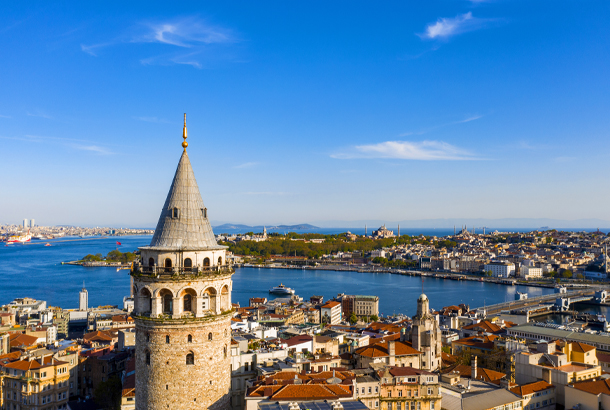
Perhaps the most famous of all the awe-inspiring buildings in İstanbul, Hagia Sophia’s iconic silhouette perched atop İstanbul’s Historical Peninsula is recognizable in nearly any photo of the city’s striking skyline. Upon its completion in 537 CE, this magnificent and colossal structure defied all logic. Constructed over a period of five years, it is known for its 32.6-meter diameter central dome, which, at a height of over 55 meters, appears to be floating in the air. Hagia Sophia is regarded as the quintessential symbol of İstanbul’s unique multicultural history.
Just across the Hagia Sophia, The Sultanahmet Mosque, which reopened its doors after a 6-year restoration, showcases its Ottoman grandeur. Its six minarets still dominate İstanbul’s skyline and a series of elegant domes, it is better known as the “Blue Mosque” because of its rich blue ceiling tiles in the İznik tradition that decorate the interior. Inside, the entrance, lit by a wrought-iron chandelier, leads into the central prayer room, which is a source of wonder with its intricate interiors decorated with thousands of tiles and natural light filtered through arched stained-glass windows. In the shrine next to the mosque are the tombs of Ahmet I and his wife, Kösem Sultan.
As you’re walking in Sultanahmet Square, imagine watching the greatest spectacle on earth taking place right from where you stand. Once an Eastern Roman chariot race course, now a peaceful park, the Hippodrome was – a stadium of splendor that could hold 100,000 people. During the Eastern Roman heyday, this site was a famous recreational and entertainment venue and hosted several events, including festivals, political parades, horse races and chariot races.
The ceremonial square has survived the ages and is deeply rooted in legendary and long-standing Eastern Roman and Ottoman history. Here, the bronze serpentine column unravels many mysteries with every bend of its winding course. The centerpiece of the Hippodrome, however, is perhaps the towering obelisk of Theodosius. Standing on an ornately carved plinth and adorned with historical inscriptions, the Hippodrome has aged gracefully over thousands of years. In the southern niches of the Hippodrome is the ancient brick obelisk, whose gilded façade leaves only a shadow of what it was today. The legendary Hippodrome, which also houses the ornate German Fountain, is the crowning glory of İstanbul.
As İstanbul was the capital of the Ottoman Empire, Topkapı Palace was the residence of sultans for 400 years. Positioned at the most strategic point of İstanbul’s Historical Peninsula, jutting out into the Boğaziçi (Bosphorus Strait), spectacular views are one of the many attractions of Topkapı. The 15th-century sultans’ residence Topkapı Palace gives you the chance to discover the Ottoman grandeur through courtyards and the mystical and absolutely beautiful harem.
Topkapı Palace offers a unique look into the life of Ottoman royalty and state affairs. Each of the complex’s successive courtyards represents a higher level of importance and intimacy to the sultan. Perhaps the most unique experience is the opportunity to stroll around the Topkapı’s private living quarters (harem), a privilege that was bestowed only upon the sultan’s family and most trusted servants. Visitors will also want to admire the rich imperial collections reflecting life in the palace. On display are artifacts relating to the palace cuisine, clothing, war memorabilia, and religious relics.
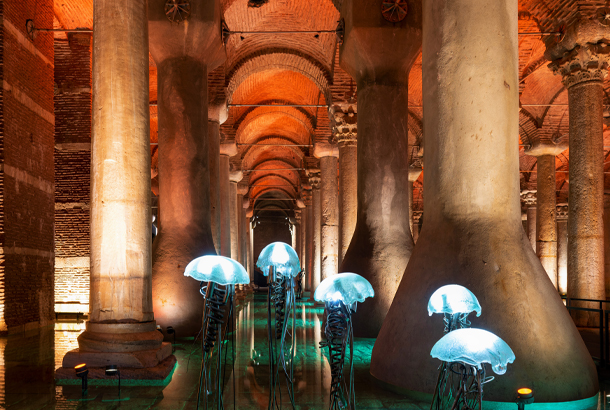
As for the 6th-century Basilica Cistern, you will descend 52 uncanny steps toward a magical experience. Built in the 6th century BCE, the Cistern lies on 9,800 square meters and is capable of holding 80,000 cubic meters of water. Today, little water is kept in the cistern so that visitors can walk between the impressive ancient columns in the dim, cavernous space. The eerie atmosphere, which was even used for the set of a James Bond film, is punctuated at the end by a column resting upon a base featuring an upturned Medusa head. It is said that Medusa was placed upside down to nullify the power of her gaze to turn those who look at her into stone. But, rest assured, the only danger facing visitors to the Basilica Cistern is an urge to return again and again to experience its captivating ambiance.
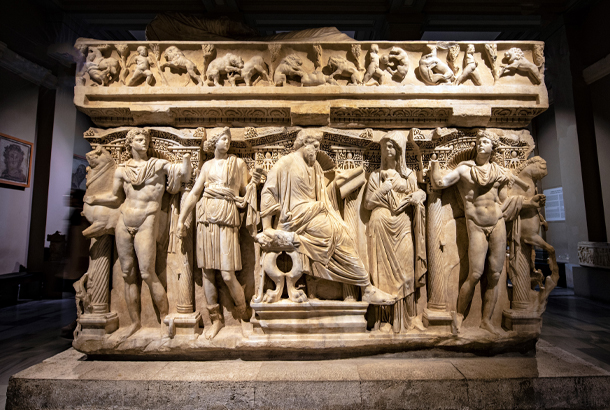
The Archaeological Museums, today, are listed as the city’s most popular museums and attractions. It is located amidst the sights of the metropolis near the famous Topkapı Palace. The Museums are separated by buildings and floors comprising the newly renovated Archaeological Museum (Arkeoloji Müzesi), the Ancient Orient Museum (Eski Şark Eserleri Müzesi), and Tiled Kiosk Museum (Çinili Köşk Müzesi). The Archaeological Museum has twenty galleries, celebrating 5000 years of history with exhibits from Eastern Roman, the Ottoman Empire and the many civilizations of Anatolia and ancient Egypt. The main building houses the finds of 19th-century archaeologist Osman Hamdi Bey, in particular, the famous 4th-century Alexander Sarcophagus discovered in the royal necropolis of Sidon in Lebanon. The Museum of the Ancient Near East houses artifacts from Egypt and Mesopotamia, including a magnificent bull frieze from the Ishtar Gate in Babylon. You will feel like you have stepped into a time machine here. But you will be immersed in a story of the history and art of the most powerful empires of antiquity.
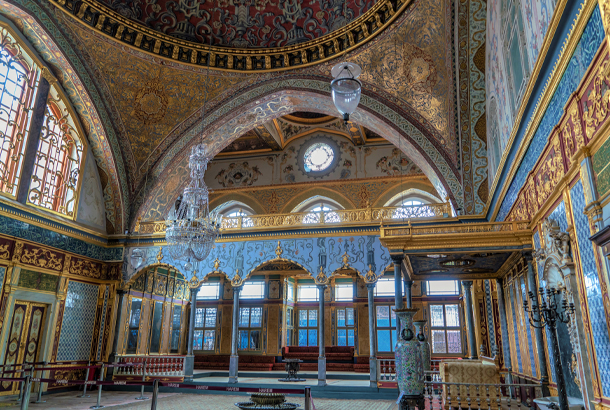
Another must-see within the ancient city walls, the Grand Bazaar is the epitome of the historical Ottoman marketplace. Often considered one of the world’s biggest tourist attractions, the graceful Grand Bazaar offers a unique shopping experience. Founded in the 15th century, the world’s largest and oldest covered market expands over a total area of 30.700 m2. With 55 streets, 20 entrances and more than 4000 shops, the bazaar offers almost limitless choices for every budget, from souvenirs to handcrafted jewelry. The shops in the bazaar present a collection of different tastes, smells, voices and textures –hammam supplies, ceramics and glassware, carpets and rugs, lamps and lights, copper work, leather goods and silk garments and all kinds of wearables. Stop by one of the traditional coffee shops to have a cup of Turkish coffee or tea to feel the dynamism and admire the daily rush of the bazaar.
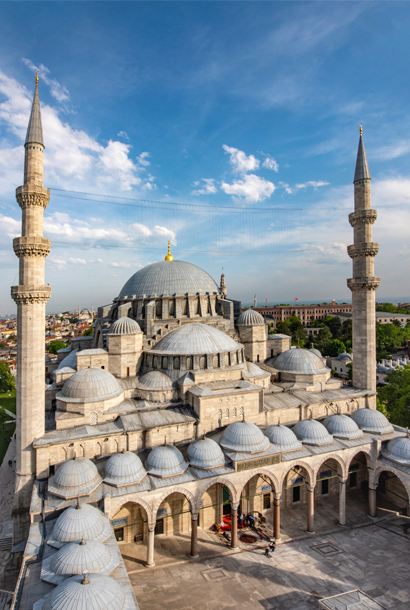
Commissioned by Sultan Süleyman, the Magnificent at the apex of the Ottoman Empire’s power, the Süleymaniye Mosque stands as a testament to the Ottoman might of this period. The dome, which has a 26.5-meter diameter and sits atop four massive monolithic columns creating an almost square interior, exemplifies the balance and powerful beauty of Architect Sinan’s work at the height of his long and distinguished career.
Across the Golden Horn, at the end of a steep slope, is situated the Galata Tower. Peeking out above the cluster of surrounding high-rise buildings, the Tower beckons visitors to the energetic neighborhoods of Galata and Taksim. Once the longest tower of İstanbul, the Galata Tower, arguably the most famous structure on İstanbul’s skyline, was originally built in 1384 by a community of Italian immigrants, mainly from the city of Genoa. The tower was originally intended as a defensive structure but has since been designated as a historical site. Today, its top balcony is the perfect address for a 360-degree view of the megapolis. The Galata Tower is located on one end of İstanbul’s famous touristic boulevard, İstiklal Caddesi (İstiklal Street – Grande Rue de Péra). A visit here at sunset is the perfect start to an evening of experiencing the area’s unique shopping opportunities and nightlife.
The 19th-century İstiklal Street, largely inspired by architectural styles from neoclassicism to art deco, offers impressive examples of passages and buildings, as well as many historic churches. Take a walk in the neighborhood to explore and admire the European face of the city.
In the lively district of Beşiktaş is Dolmabahçe Palace. Constructed in the later years of the Ottoman Empire, İstanbul’s third largest palace is a magnificent work of Neoclassical style. The palace’s sumptuous and luxurious interior is a heavenly mosaic of gilded ceilings, effervescent chandeliers, crystal staircases, and genuine bearskins. Now a museum, visitors today have the opportunity to admire the craftsmanship of its ornate exterior before being enchanted by the imperial luxury of the rooms and their furnishing.
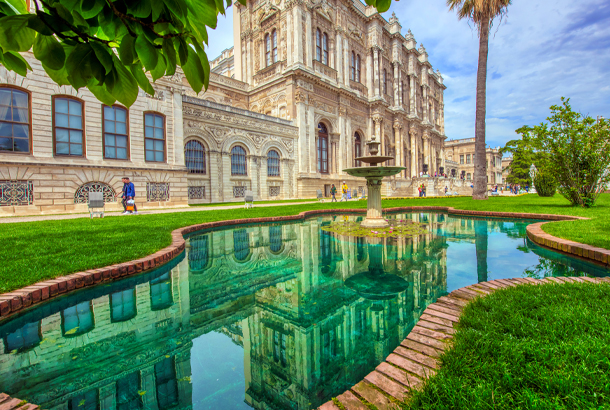
Sitting at the entrance of the Bosphorus, The Maiden’s Tower (Kız Kulesi), was initially constructed in the fifth century BC on an islet about 20 meters from the present-day coast of Üsküdar as a customs checkpoint to manage ships traveling through the Boğaziçi s and collect taxation. On this tiny islet, the Eastern Roman Emperor Manuel Komnenos ordered the construction of a defense structure in the 12th century. An iron chain that extended from the tower to another tower on the Historical Peninsula took control of the Boğaziçi’s entry and departure. During the Ottoman period, a wooden tower was built here and served as a watchtower, a lighthouse and a quarantine site in the upcoming centuries. Situated in the middle of the Boğaziçi as a beautiful girl displaying İstanbul‘s beauty, the newly renovated Maiden’s Tower lights up the city during nighttime.
In a modern metropolis like İstanbul, there is no limit to the options you are offered when it comes to history. You may choose to visit centuries-old seaside Ottoman palaces and mansions along the Boğaziçi.
And today, İstanbul is a renaissance of art, music and culture, known for its rich historical heritage. It has woven a tapestry of creativity that is the envy of cultural cities around the world, with revitalized and redeveloped neighborhoods and waterfronts welcoming a new wave of museums, design-conscious architecture, restaurants, bars, cafés and definitive cultural centers. İstanbul is a city full of historical surprises; set your own pace and let the city envelop you.


